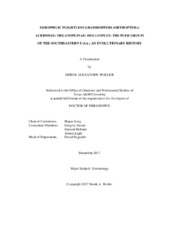| dc.description.abstract | The 27 flightless grasshopper species of the Puer Group (Orthoptera: Acrididae:
Melanoplinae: Melanoplus) comprise a biological system of fascinating complexity in
the southeastern U.S.A. that was heavily influenced by sea level fluctuations during the
Pliocene and Pleistocene, especially during the latter. These shifts resulted in an oceanic
island system that can now be classified as a landlocked archipelago, one that still
reflects the patterns of its ancestral roots in terms of speciation and dispersal. To better
understand speciation patterns in this group, I used several synergistic methods:
molecular-based phylogenetic reconstruction, divergence time estimation, correlative
microscopy and 3D model reconstruction of copulation, and shape analysis of male
genitalia in an evolutionary time-based phylogenetic framework.
As predicted, aside from general sea level changes, my evidence indicates that
the biogeographical and speciation history of this system was shaped dominantly by
allopatry in the form of oceanic islands in the past and, more recently, sympatry via
sexual selection, especially for the species in peninsular Florida. My quantitative
evidence also added strong support for the concept, especially in light of evolutionary
time, that sexual selection can drive genital evolution divergently and rapidly. My
investigation of the function of genital components (some new to science) during
copulation was combined with shape analyses of five of those genital components to
reveal that sexual selection’s evolutionary tempo on these components is accelerating
and/or decelerating. The relative speed was found to be dependent upon the component
and its associated function(s). I also discovered that one of the youngest Puer Group
clades has speciated at a rapid rate that may possibly be the highest yet for insects.
The obvious complexity of this biological system requires additional
investigation at finer scales to further dissect the intriguing patterns and processes of
evolution herein revealed to be at work. Continued analyses of the Puer Group, both
quantitative and descriptive, are encouraged, especially because the threat of destruction
and fragmentation of the group’s xeric habitats (especially scrub) looms large.
Speciation is still largely a biological black box, but its inner workings will continue to
be slowly revealed with further illuminating studies like this one. | en |


